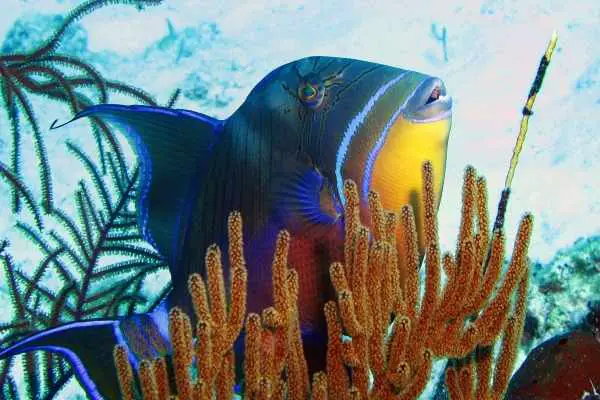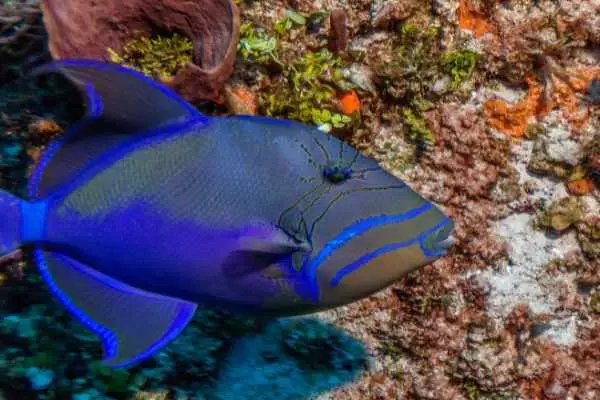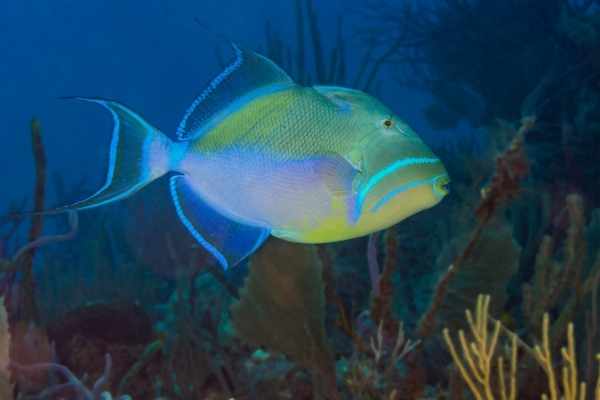The queen triggerfish (Balistes vetula) is one of the most iconic saltwater fish patrolling the Atlantic Ocean. Their gorgeous colors appeal to any aquarist looking for a dramatic centerpiece species. Unfortunately, their sheer size and aggressive habits make them unsuitable for most home aquariums. If you’re looking to add one of these royal brutes to your collection, you have your work cut out for you.
Table of Contents: Queen Triggerfish Care
Who doesn’t love fish with boisterous personalities? Queen triggerfish definitely fit that bill. And if you can accommodate their care needs, you’ll find yourself making excuses to duck over to the tank and interact with your new fish. As you’ll note when you visit the links below, though, it’s the demanding management that often makes hobbyists think twice about bringing this particular trigger home.
- Quick Facts
- Description of the Queen Triggerfish
- Queen Triggerfish Lifespan
- Creating the Ideal Queen Triggerfish World
- Queen Triggerfish Diet
- Queen Triggerfish Behavior and Tank Mates
- Breeding the Queen Triggerfish
- Pros and Cons
- For More Information

Quick Facts
- Common Names: Queen triggerfish
- Scientific Names: Balistes vetula
- Size: 24 inches (60.9cm)
- Minimum Tank Size: 500 Gallons (1893L)
- Reef Safe? No
- Care or Experience Level: Moderate
- Preferred Diet: Carnivore
- Original Part of the World: Atlantic
Description of the Queen Triggerfish
As with most triggers, the queen triggerfish boasts a flattened football shape. That doesn’t earn them a place at the top of the popularity list. Nope, it’s the flashy scales that do the trick. Across the top half of the body, you see a wide band of green transitioning to blue and then gray. Along the bottom, they’re a bright orangish-yellow. And around the lips – sheltering sharp, constant-growing teeth – you’ll note a bright blue ring that sweeps back to the pectoral fins. Another blue bar picks up around the tail and down the median fins.
Juvenile queen triggers aren’t quite as flashy, though the color palette remains the same. Youngsters also possess smaller fins. As they age, the tail develops long, trailing filaments. Males will show the most dramatic filaments and colors, especially during the spawning season. It’s the easiest way to differentiate the two sexes.
In addition to the locking spines present in every trigger, queen triggerfish possess special membranes behind their pectoral fins. When fluttered, the membranes generate a “grunting” sound to warn potential predators and competitors away. As queen triggers can rotate each eye independently (think chameleon), this vocal warning system works as they perform their daily patrols.
Queen triggerfish are popular for the aquarium and fishing trade (if you’ve had turbot in a restaurant, it’s the same fish). In the Caribbean, local fishers also dry the skin to produce sandpaper. Unfortunately, the heavy collection pressure has increased since 1990. And now queen triggerfish are listed as Near Threatened on the IUCN Red List. It’s one of the first hesitations for hobbyists considering picking up the species for their home aquarium.

Queen Triggerfish Lifespan
Queen triggerfish span the coastal waters of the Atlantic. They prefer rocky terrains and reefs as a preference, but you’ll also spot them over seagrass beds. With so much room to stretch their fins, they form loose schools. But now and then, a diver will come across a lone queen trigger in the warmer waters.
While friendly and personable to caretakers in captivity, it’s important to observe care in the wild. Queen triggers during the spawning season get AGGRESSIVE. People end up with nasty bites when they get too close. It’s easy to tell the difference, too: Most of the time, these colorful fish are shy and dart out of the way.
Still, it’s easy to identify individuals from the pattern of their scales. So snorkelers and divers recognize fish in familiar haunts. Triggers reach maturity around 9-11 inches (22.8-27.9cm) in length. And queen triggerfish live for around 7-13 years.
Creating the Ideal Queen Triggerfish World
While most people associate queen triggerfish with the tropical region, you can spot them as far north as the Canadian border and around Massachusetts. (Not too many reefs up there, but there’s plenty of rocky terrain) In the eastern portion of the Atlantic, they’re found in the Azores and around Cape Verde. As you go south, they drop off around Brazil and Angola.
Queen triggers look for habitats that provide the meals they crave. That means HARD shellfish. They’ll take corals and sponges, too, of course, but they prefer sea urchins and crustaceans. So it’s no surprise that divers have noted these triggers throughout the water column: 10-900 feet (3-275m). For the most part, though, they stay around 10-100 feet (3-30m).
When you start considering your aquarium, you want to look at the behavior and diet of the queen triggerfish. They spend most of their time exploring and hunting for their next meal. As such, you want plenty of open swimming space. (We’ll go into exactly how much space in a moment) But you also need to offer live rock for them to poke around – and chew.
Triggerfish teeth grow constantly. Without rock, sponges, and appropriate dietary items to wear down those chompers, the teeth can OVERGROW. Then your queen triggerfish won’t be able to eat. Not to mention they’ll end up in pain. So you want an environment that offers “chew toys” appropriate for your gorgeous fish.
Queen triggers – like all triggers – also use caves and crevices in live rock to retire into for the night. One spine wedges the fish in place while the second rereleases the fish in the morning. Of course, you need to make sure the structures you set up can accommodate the size of the fish. This can translate to a significant creation of rockwork.
However, queen triggers are also destructive. They like to rearrange everything you set up in your tank. If you don’t secure live rock structures, they can get toppled in the process. Not a big deal to your queen triggerfish, but a potential disaster for tank mates. Check that all of your aquascaping can survive the poking and prodding of a curious, LARGE fish.

Queen Triggerfish Tank Size
Hobbyists usually pick up juvenile queen triggerfish. And the species doesn’t reach sexual maturity until around 11 inches (27.9cm). That’s not an unimpressive size to begin with, but this species continues to grow. As adults, they reach a whopping 24 inches (60.9cm)! That’s a massive fish requiring TONS of room to swim in.
Queen triggerfish need a minimum of 500 gallons (1893L) – and that’s for ONE fish. You can start your youngster in a smaller aquarium, but you need an appropriate tank ready for when they grow. All of that room is necessary to provide the open space they need for swimming and the live rock they’ll explore and sleep in.
As if that weren’t enough, you need to invest in STRONG filtration. Queen triggers are messy eaters and carnivores, to boot. Without biological and mechanical filters to clean up after them, you’ll find yourself with failing water conditions. A top protein skimmer and an attached sump aren’t bad ideas, either.
Then you need to do your best to disguise or remove all of the wires and tubes from the tank. Queen triggerfish like to chew. They don’t particularly care WHAT they chew. And you don’t want to wake up one morning and find they gnawed through a filtration tube. (Offering plenty of alternatives will help, too)
Are Queen Triggerfish Reef-Safe?
While divers and snorkelers often spot schools of queen triggerfish swimming over reefs in the Atlantic, you should resist the temptation to add one of these fish to your prize reef tank. They’re the furthest thing from reef-safe!
Remember that chewing habit? Yeah, queen triggers have no problem filing down their teeth with your favorite corals. Actually, any hard sessile invertebrate is potentially at risk. This includes clams, snails, and sponges.
You also want to avoid mixing triggerfish and crustaceans. Crabs and shrimp make up some of their menu favorites. And those shells? Yeah, they work nicely for filing down queen triggerfish teeth. In no time, you’ll see your ornamental shrimp disappear from the tank. It’s better if you keep this species in a fish-only tank.

Queen Triggerfish Diet
Queen triggerfish are carnivores. That shouldn’t surprise anyone. (Not when they don’t hesitate to bite divers during the spawning season!) The sharp teeth in their blue lips are designed to crush crunchy delights. And they’ve perfected the art of flipping sea urchins over to get at the unprotected undersides. So you need to come prepared to satisfy their craving for meat AND ensure you’re caring for their teeth.
The best way to do this is to offer food in a shell. Mussels, shrimp, and clams will provide the protein your queen trigger’s hunting and wear down those fangs. But if you have sponges and live rock available as “chew toys,” you can offer additional menu options:
- Chopped Fish
- Krill
- Squid
You may spot your queen triggerfish nibbling at the macroalgae growing in your tank. They’re not ill. But you also shouldn’t assume they’ve turned vegetarian. Algae won’t prevent the overgrowth of those teeth. And you don’t want dental problems. A queen trigger that can’t eat will need manual Dremeling. Most hobbyists aren’t up to the task. (Not to mention the stress it creates in the fish!)
Queen Triggerfish Behavior and Tank Mates
Despite their terror among the hard-shelled invertebrate community, queen triggerfish are shy – in the wild. They usually dart out of the area when divers attempt to follow them. And they start up that guttural sound with the pectoral membrane to divert other fish from getting too close. If feeling threatened, they deploy the trigger and wedge into a crevice.
It’s when you move the species into a captive environment that you see an aggressive streak emerge. The sheer size of the fish turns them into a bully. And they (inadvertently) wreak havoc as they rearrange rockwork. Attempting to keep a queen trigger in an aquarium that’s too small only exacerbates these problems.
In theory, you CAN keep a school of queen triggerfish. You’d need a MAMMOTH aquarium to do so, though. It’s usually out of the realms of possibility for the average aquarist. Even commercial aquariums usually stick to solo fish due to their destructive habits. If you feel up to the challenge, though – and have a room or two to spare – they’ll tolerate sharing space.
The only way to keep these brutes in check is to add them to the tank LAST. And you want your queen triggerfish to be the SMALLEST fish in the community. Of course, when you’re looking at an adult size of 24 inches (27.9cm), that doesn’t leave you with many options. Most aquarists pair them with other aggressive or semi-aggressive species:
- Large angelfish
- Damselfish
- Moray eels
- Surgeonfish
- Wrasses
There IS a limit when you go for the “bigger is better” theory, though. The flowing filaments on the queen triggerfish’s tail present a temptation for other species. And you don’t want your beautiful fish to spend their entire life wedged into a cave. So (provided you had the space in the first place), you’ll need to avoid these tank mates:
- Groupers
- Jacks
- Sharks

Breeding the Queen Triggerfish
Due to the spatial needs of the queen triggerfish, you don’t see hobbyists breeding the species. When you throw in their spawning behavior, it’s even more of a complication. As such, they’re usually wild-caught.
Males and females share similar appearances. The male queen trigger is larger with longer filaments off the tail. And during spawning season, he has brighter colors. You’ll want to make sure you’re looking at a full-sized adult before you attempt to tell the sexes apart, though, or you may mistake a juvenile male for a female.
Queen triggerfish spawn throughout the year. However, you see peaks in the fall and winter. Males set up territories on the seafloor of around 33 feet (10m). They perform a courtship ritual and use their colors and filaments to attract multiple females into the area. The females then hollow out a nest in the sand by blowing water and rapidly fanning their pectoral fins. They lay the eggs into the nest, and the male fertilizes them.
Both sexes defend the territory while the eggs develop. This is when divers often receive nasty bites. Approaching parents incubating nests is a recipe for disaster. (Remember, queen triggerfish are usually SHY) Once the eggs hatch, the fry disperse onto the reef.
Trying to simulate this situation in the average home aquarium is impossible; hobbyists simply lack the space. Coping with the resulting aggression could also get tricky. You’d end up with injured or dead tank mates. Unfortunately, it’s part of the reason the species sees high collection numbers.
Pros and Cons
Queen triggerfish awe and inspire anyone that sees them. They’re popular with photographers – to say nothing of their fans in the culinary world. And while seeing those beautiful colors in the fish store would tempt anyone, it’s important to balance the pros and cons before you open your bank account.
Pros
- Queen triggerfish develop personal relationships with their owners, interacting and displaying fun behaviors.
- From the “triggers” to the pectoral membrane, queen triggers come with plenty of unique adaptations you can discuss and point out to visitors.
- Queen triggerfish adapt well, and they get along with large aggressive and semi-aggressive fish.
Cons
- Queen triggerfish are NOT reef-safe; they use coral, crustaceans, and sessile invertebrates to file down their teeth.
- In captivity, queen triggers shed their shy nature and often turn aggressive toward other fish.
- Queen triggerfish are often destructive in aquariums; they chew on rubber and plastic equipment and rearrange aquascaping.
For More Information
When you spot a queen triggerfish – whether in a stunning image or at an aquarium – you’ll never get the species out of your mind. They’re stunning. And if you’re willing to cope with those hefty care needs, there’s no reason you SHOULDN’T consider adding one to your collection. So let’s look at a few other key bits of information, shall we?
This YouTube video shows a queen triggerfish on the hunt (so you can see those teeth in action):
Want to know about some of the best queen triggerfish tank mates?
Maybe you like the idea of triggers, but the queen triggerfish is a bit out of your reach. Not a problem:
Conclusions
Queen triggerfish are stunning to behold. They stand out, even on the most colorful reefs. Of course, they also stand out with their care needs. You’ll want to check every box if you want to keep your queen trigger happy and healthy. (Or, you know, avoid the loss of an ornamental invertebrate)
If you genuinely love the species and can’t do without it, make sure you do your homework. And watch those teeth!

References
- Crandall, D.A. 2002. “Triggerfishes.” Reefkeeping Magazine.
- Fenner, B. “Bruisers and Cruisers: The Triggerfishes. Family Balistidae.” Wet Web Media.
- Keene State. “Queen Triggerfish.” A Student’s Guide to Tropical Marine Biology.
- McDavid, J. 2007. “Aquarium Fish: Triggerfish.” Advanced Aquarist.
- Michael, S.W. 2006. Reef Aquarium Fishes: 500+ Essential-to-Know Species.


Leave a Reply